Designing a dining room that works for both daily meals and special gatherings? It’s not as tricky as it sounds. The sweet spot is somewhere between comfort and style.
Remember to repin your favorite images!
A great dining room design brings together the right table shape, seating, and lighting. You want it to feel inviting for weeknight dinners but also able to switch gears for entertaining.
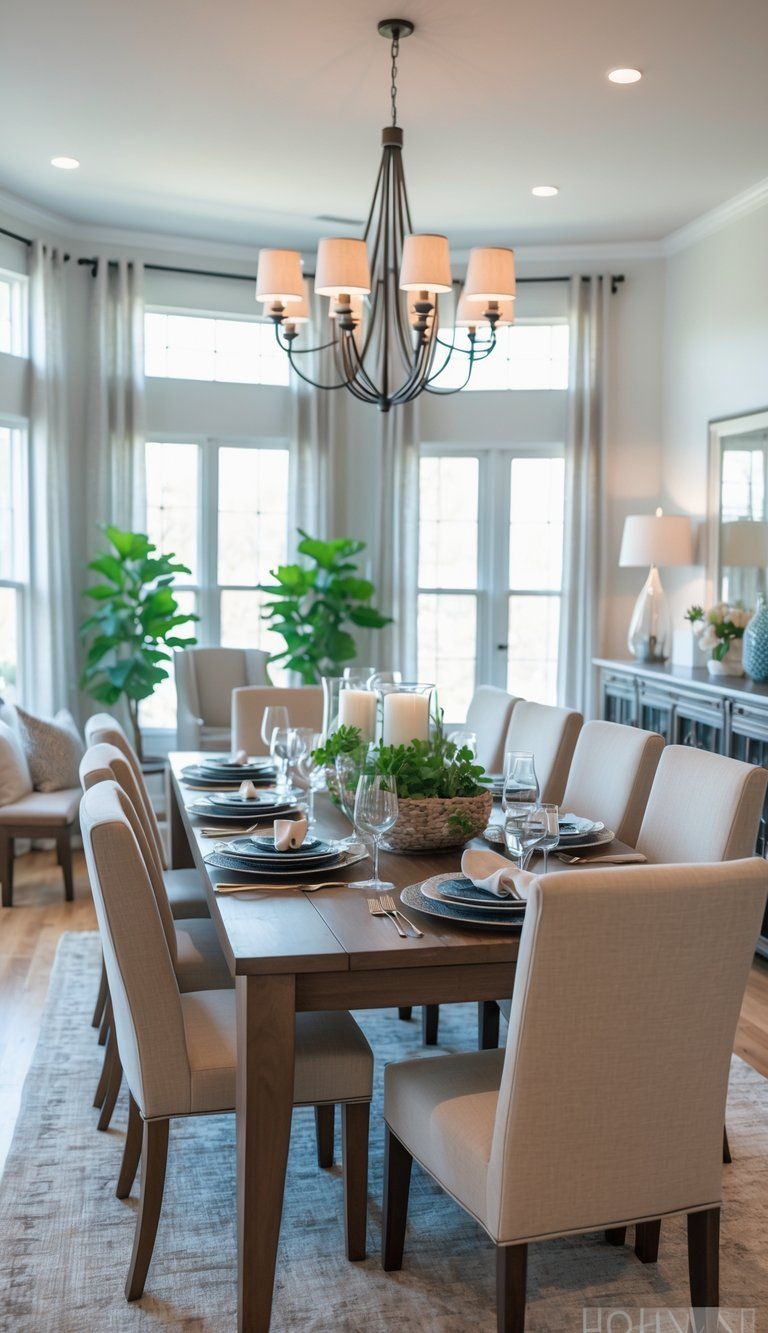
A lot of homeowners find their dining rooms feel either too fancy for everyday use or too laid-back for hosting. Striking a balance really comes down to smart layout choices and picking versatile pieces.
Think about a table that expands when you need it, chairs that are comfy enough for long chats, and lighting that shifts from bright and functional to something softer and more intimate.
Let your dining space reflect your lifestyle, but keep it flexible. Maybe you have a dedicated dining room, or maybe it’s just a zone carved out of an open floor plan.
The right mix of furniture, color, and accessories can make people just want to hang out there. Dimmable lights, cozy chairs, and storage nearby help your dining area do more, no matter the occasion.
Essential Elements of a Functional Dining Room
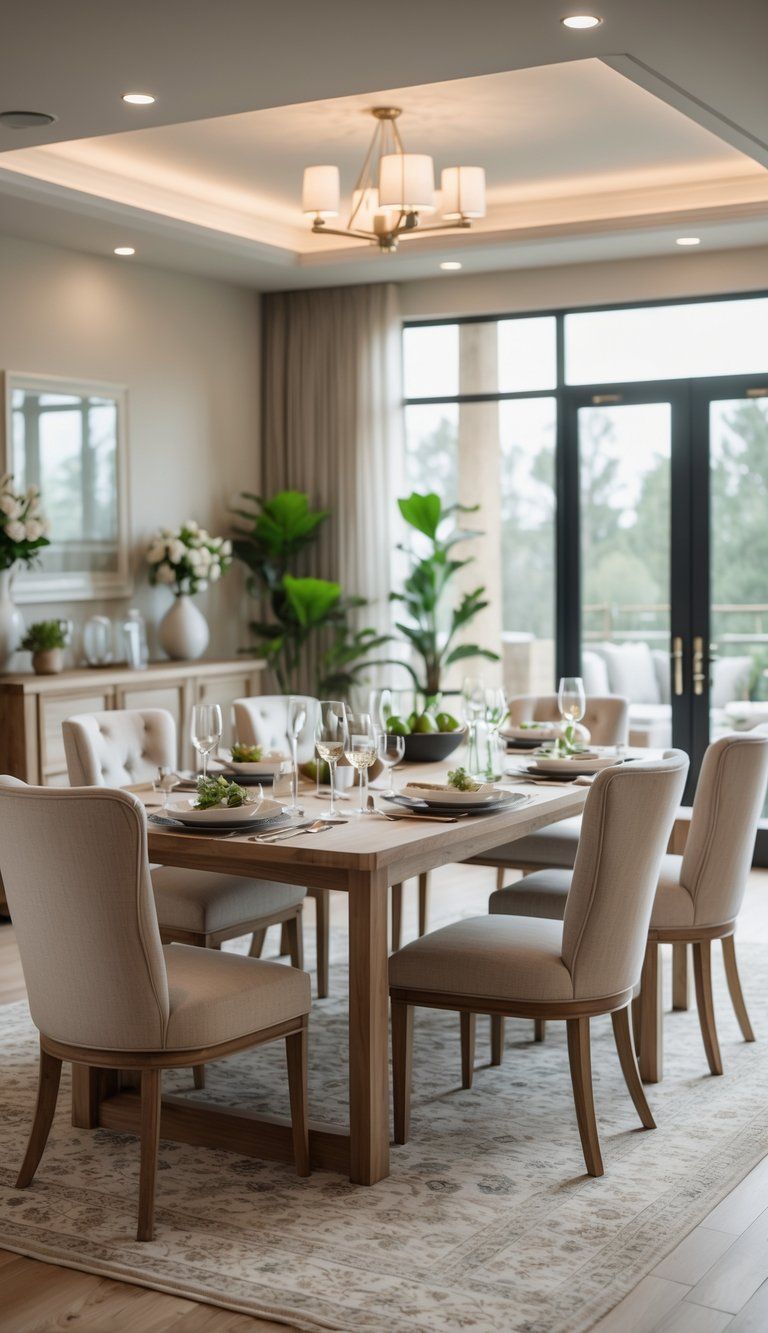
If you want a dining room that works for both everyday meals and special occasions, you have to get the basics right. The right table, chairs, and room size will serve you well for years.
Dining Table Selection
The dining table is the heart of the dining room. When you’re picking one, think about your space and how you actually use it.
Table shapes make a difference:
- Round tables work in smaller spaces and make conversation easy.
- Rectangular tables suit long, narrow rooms and can seat a crowd.
- Square tables feel intimate for small groups but don’t work as well for big gatherings.
- Oval tables give you the flow of a round table but can fit more people, like a rectangle.
Put your everyday needs first. If you host big dinners often, a table with leaves or extensions is a lifesaver.
Solid wood holds up over time, but glass can make a small space feel airier.
Choosing the Right Chairs
Chairs matter more than you’d think—people might sit for hours, so comfort counts.
Chair options to try:
- Upholstered chairs are cozy for longer meals.
- Mix-and-match styles (especially with upholstered end chairs) keep things interesting.
- Benches are great for casual vibes and squeezing in a few extra guests.
Aim for 24 inches of width per person. Leave 10-12 inches between the chair seat and the underside of the table.
If you love long dinners, pick chairs with supportive backs. Removable seat covers or performance fabrics are a bonus if you have kids or throw a lot of parties.
Dining Area Size and Proportion
How big and open your dining area feels really affects comfort and flow.
Leave at least 36 inches between the table and any walls or furniture so people can get in and out easily. If you have a serving area or a lot of foot traffic, 48 inches is even better.
A few space planning tips:
- A 10×10 foot room fits a table for 4-6 people.
- For bigger groups, allow about 3 feet of table length per person.
- Center the table for balanced traffic flow.
Hang lighting 30-36 inches above the table. If you have high ceilings, pick a fixture that fits the scale.
Area rugs should stretch at least 24 inches beyond the table, so chairs don’t catch on the edge when you pull them out.
Dining Room Layouts That Balance Everyday Use and Entertaining

If you want your dining room to work for both family meals and entertaining, you’ll need a thoughtful layout. The right setup can turn a rarely used space into the real heart of your home.
Functional Layout for Daily Meals
Start by putting your table in a spot that’s practical for daily life. Families usually want the table close to the kitchen, so it’s easy to serve food.
Round or oval tables are nice for daily use—they’re friendly for conversation and don’t have sharp corners in busy areas.
Think about your family’s routines. If the table doubles as a homework station, make sure there’s good lighting and maybe a cabinet nearby for supplies.
Wall shelves or a slim console can hold everyday stuff without making things feel cramped.
Built-in storage like a sideboard or buffet keeps things like placemats, napkins, and dishes close. Try to keep the tabletop mostly clear, with just a simple centerpiece you can move when needed.
Flexible Seating Arrangements for Guests
When you’re hosting, your dining room needs to flex. Get a table with leaves so you can grow the seating as needed.
Mix and match seating for flexibility:
- Dining chairs for everyday
- Benches to squeeze in more people
- Stackable chairs you can stash away when not needed
- Ottomans or stools that can double as extra seats
Don’t clutter the dining area with too many chairs every day. Keep just enough for the family, and pull in extras from nearby rooms as needed.
Armless chairs save space and tuck all the way under the table.
Optimizing Flow in Open Floor Plans
In open-concept spaces, use a big area rug to define the dining zone—make sure it extends 24 inches past the table on all sides.
Place your table so people can walk around it easily. Leave at least 36 inches between the table and any walls or furniture, even when chairs are pulled out.
Think about what you see from the dining table. Face seats toward windows or conversation areas, not the kitchen mess.
A low bookcase or console can act as a divider between dining and living spaces, plus give you some extra storage.
Lighting really matters here. Hang a bold pendant or chandelier over the table to anchor the space.
Banquette and Nook Solutions
A corner banquette can be a game-changer in small spaces. Built-in benches along a wall make a cozy nook and seat more people than chairs alone.
Tuck storage under the banquette for things you don’t use every day, like:
- Special occasion dishes
- Table linens
- Holiday stuff
- That bread maker you never use
Pair a banquette with a pedestal table for easy in-and-out, especially if space is tight. Pick a table you can push against the wall for daily meals and pull out when you have company.
Throw in some pillows for comfort during long dinners. Go for stain-resistant fabric—this spot sees a lot of use. Performance fabrics like Sunbrella or Crypton are tough enough for spills and frequent cleaning.
Creating a Welcoming Atmosphere
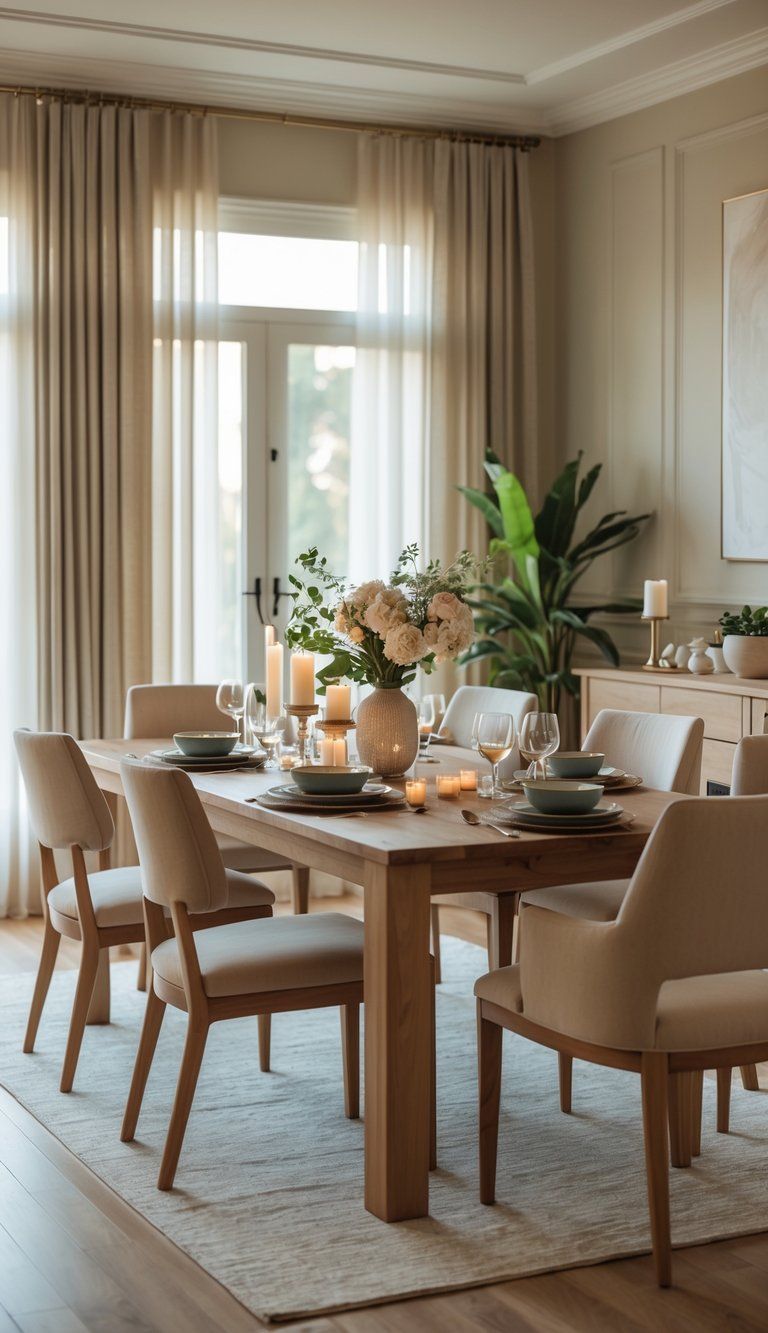
The atmosphere is everything in a dining room. A welcoming space comes down to good lighting, the right colors, and a focal point that draws people in.
Lighting Strategies for Ambiance
Lighting can totally change the mood. Layer your lights for flexibility—start with a bold chandelier or pendant over the table to set the tone.
Hang it about 30-36 inches above the table for best results. Add wall sconces or a buffet lamp for a softer glow and fewer harsh shadows.
Get dimmers if you can. Bright light is great for family meals or homework, but softer light creates a cozy vibe for dinner parties.
Smart lighting systems can save you some hassle—just press a button to set the mood.
Color Palette and Decor Choices
Color sets the mood fast. Warm neutrals like taupe, gold, or terracotta feel instantly inviting. Blues encourage conversation, and greens bring a calm, natural feel.
Try the 60-30-10 rule: 60% main color (walls), 30% secondary (furniture), 10% accent (accessories). It keeps things interesting but not overwhelming.
Layer in textiles—curtains, table linens, chair cushions—to add warmth. Mix up textures: smooth with rough, shiny with matte.
Keep decor meaningful. Choose pieces that spark conversation, like a favorite art print or a small gallery wall, but don’t let clutter take over.
Setting a Focal Point
Every great dining room needs a focal point. The table usually does the trick, but you can amp it up.
Try a bold wallpaper or mural on one wall for instant impact. Patterns or textured designs behind a buffet or sideboard work wonders.
Statement lighting pulls double duty—lighting your meals and adding style. Go for something that feels like you, whether that’s modern glass or a traditional chandelier.
Built-ins like a china cabinet or wine rack can become natural focal points, especially if you style them with things you love.
Storage and Display Solutions
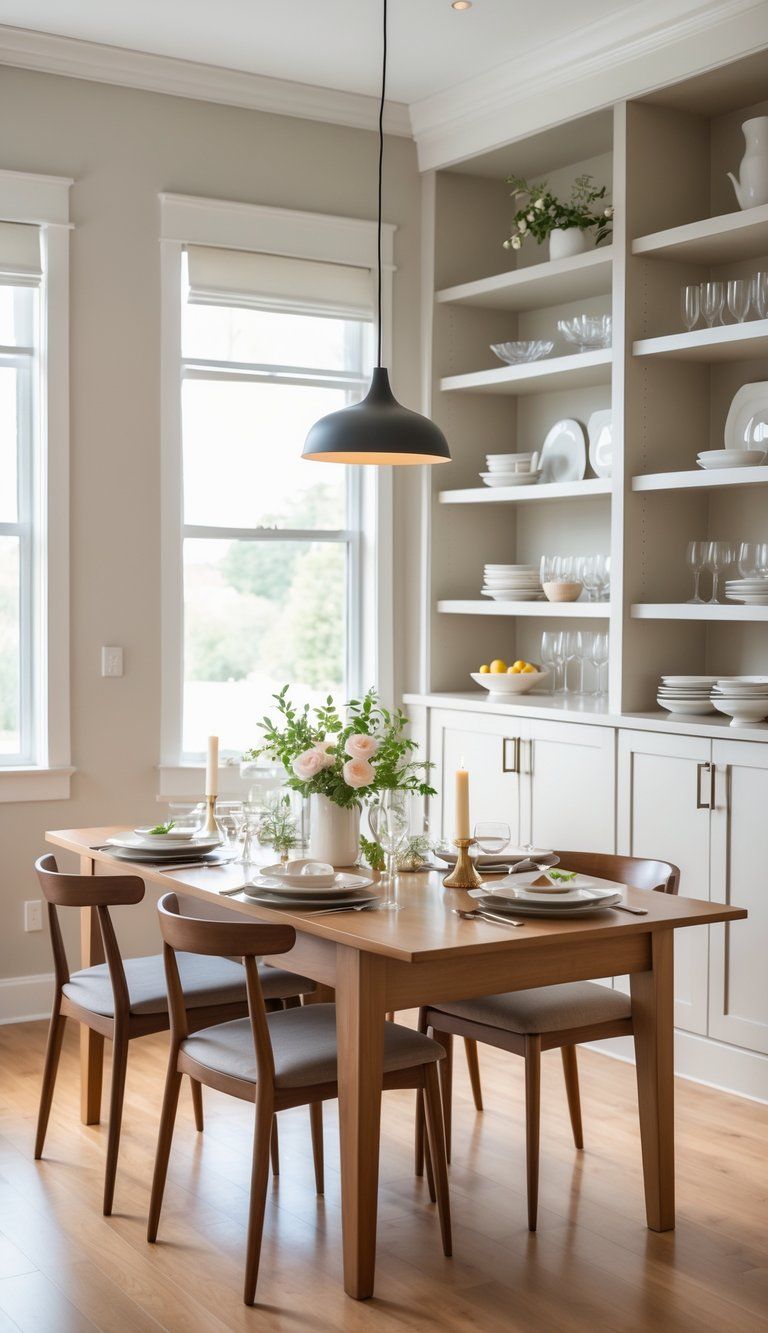
Smart storage can turn your dining room into an organized hub for both daily life and entertaining. The right pieces hold your essentials and show off your favorite things—without clutter.
Built-In and Freestanding Cabinets
Built-in cabinets blend right in with your dining room’s architecture. These custom solutions make the most of wall space and can be tailored to what you actually need.
Floor-to-ceiling cabinets with glass doors let you display special dishes, while solid doors keep the everyday stuff hidden.
Freestanding cabinets offer flexibility if you like to switch things up. Adjustable shelves help you fit everything, from tall pitchers to tiny cups.
A tall cabinet with a mix of open and closed storage gives you a spot for decor and a place to stash less pretty essentials.
In small dining rooms, corner cabinets are sneaky-smart. They tuck into unused corners and can hold a surprising amount of stuff.
Sideboards, Credenzas, and China Cabinets
Sideboards and credenzas are workhorses for both storage and style. They usually have drawers and cabinets—perfect for table linens, serving pieces, and things you only use sometimes.
Put a sideboard along the wall opposite your table for balance. The top can be a buffet during parties or just display lamps and decor the rest of the time.
China cabinets are a classic for showing off heirloom dishes and glassware. Modern ones are slimmer and often come with better lighting.
Look for cabinets with LED lights to highlight your collection—no heat, just a nice glow.
If you need flexibility, a credenza with sliding doors is handy, especially in tight spaces. Some new designs even have charging stations or wine storage, which is pretty clever.
Designing for Different Dining Room Styles
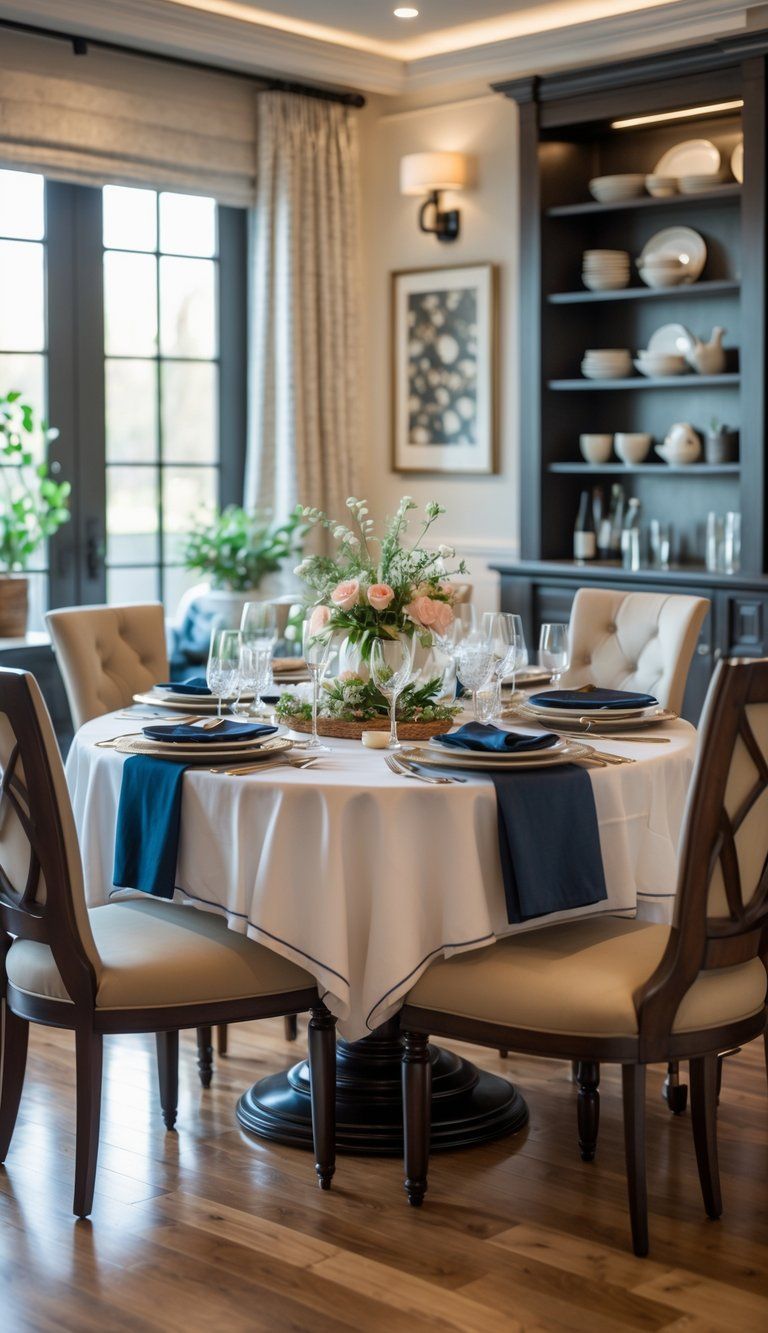
Your dining room should show off your personal style but still work for everyday meals and special gatherings. The design you choose can really change the mood and function of the space.
Modern Dining Room Design
Modern dining rooms lean into clean lines and keep decor minimal. Make a sleek table with simple shapes the star of the room.
Pick chairs that feel comfortable and have very little decoration. Stick to neutrals for your main colors, but don’t be afraid to add a pop of color here and there.
Think about matte black fixtures, white walls with maybe just one accent wall, and natural materials like glass or polished wood. Lighting is absolutely key in modern dining rooms.
Hang pendant lights with bold, architectural designs right over the table. Use built-in storage with hidden handles to keep things looking tidy and modern, but still practical.
If you want that true modern vibe, skip the clutter. Go for one or two statement pieces—maybe a dramatic art print or a sculptural centerpiece. Don’t overdo it with lots of little decorations.
Traditional Dining Room Elements
Traditional dining rooms give you that timeless elegance. Start with a sturdy wooden table, usually rectangular, with some detailed edges or turned legs.
Choose upholstered chairs that feel comfortable and classic. Some favorite traditional touches include crown molding, wainscoting, and a crystal or brass chandelier.
Rich wood tones and symmetrical furniture arrangements really set the scene. Warm neutrals or deep jewel tones on the walls work beautifully.
Add a sideboard or buffet for storage and serving—it’s both functional and a great place to show off heirlooms. Layered window treatments, like pinch-pleat curtains or Roman shades in velvet or silk, add a sense of luxury.
Farmhouse Charm and Rustic Touches
Farmhouse dining rooms just feel welcoming, don’t they? The heart of the space is usually a big rectangular table made from reclaimed or distressed wood.
Mix up your seating for a bit of character. Try a bench on one side, or combine chair styles that share a similar color or finish. Windsor chairs or ladder-backs in natural wood make great options.
Pick lighting that feels solid but not fussy, like iron chandeliers, lantern pendants, or even mason jar sconces. Decorate with vintage kitchenware, shiplap or beadboard walls, and natural fabrics like linen or cotton.
Keep your colors light—whites, creams, and soft blues help create that easy farmhouse charm.
Mid-Century Modern Inspiration
Mid-century modern dining rooms combine function with cool, organic shapes. Look for a dining table with tapered legs and a smooth wood surface, maybe in teak or walnut.
Let your chairs make a statement, too. Molded plastic chairs in bright hues, wooden chairs with sculpted lines, or any slim, curved profile can work. Earthy tones with a few bold pops—like mustard yellow, teal, or burnt orange—keep things lively.
Stick to simple, geometric patterns. Lighting grabs attention in these rooms; try a sputnik chandelier or a globe pendant at just the right height.
A sideboard with slim legs gives you storage but keeps the space feeling open and light.
Entertaining in the Dining Room
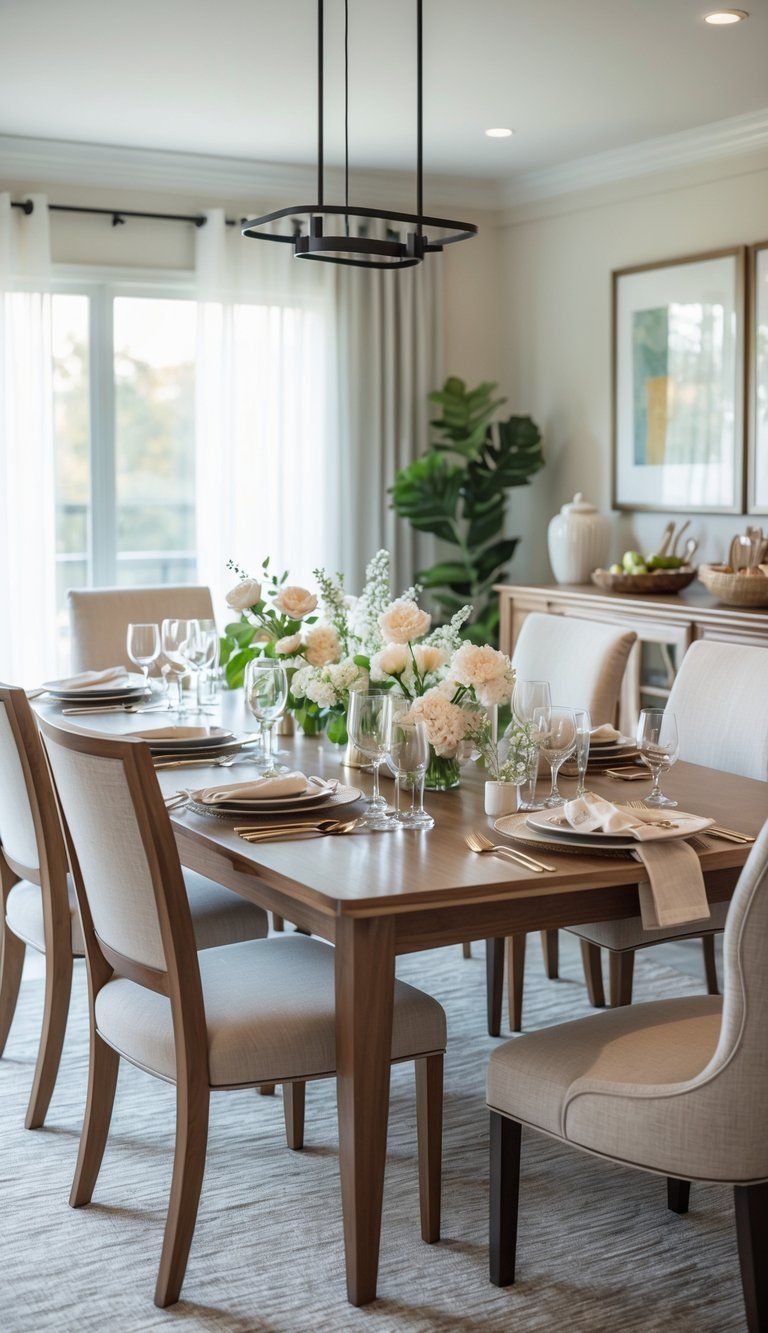
Your dining room can easily become the heart of your home’s social life. With a few tweaks, you can turn the space from a casual eating spot into a sophisticated entertainment hub that impresses your guests.
Setting Up for Special Occasions
When you’re planning a special dinner, start with your table setup. For formal meals, give each guest about 24 inches of space—no one likes to feel cramped.
Space place settings about 15 inches apart from center to center. Lighting sets the tone fast, so install a dimmer switch for flexibility.
Aim for a cozy, flattering light—around 2700K to 3000K is usually perfect for evening gatherings. Use layers of light: chandeliers or recessed lights for general brightness, buffet lamps or sconces for tasks, and candles or small lamps for ambiance.
Think about seating flexibility, too. Keep a couple of folding chairs or stylish ottomans handy for surprise guests.
A bench on one side of the table can seat more people than individual chairs if you need to squeeze in a few extras.
Incorporating a Home Bar or Wet Bar
A dedicated bar area can seriously level up your entertaining game. If you have the space, a built-in wet bar with a small sink makes cleanup easy.
If not, a cool bar cart does the trick. Stock your bar with the essentials: wine, cocktail, and water glasses, a few basic spirits and mixers, an ice bucket, and decent bar tools.
If you can, add a small fridge. Keep your bar close enough to serve guests but out of the main traffic path—three or four feet from the table usually works well.
Glass-front upper cabinets show off special glassware, while under-cabinet lighting adds a nice glow and highlights your bottles. Set wine fridges to about 55°F for storing both reds and whites.
Tabletop Accessories and Seasonal Decor
Accessories make your dining table feel special. Start with good-quality neutral table linens. Swap in seasonal runners or placemats when you want a change.
Invest in cloth napkins—cotton or linen are always nice. White dinnerware goes with everything, and simple glassware and decent flatware round out your basics.
Change up your centerpiece for the seasons. Summer might mean fresh flowers or potted herbs. In fall, go for mini pumpkins or autumn leaves. Winter looks great with evergreen branches and a little sparkle.
Candles always help set the mood. Stick to unscented ones so they don’t compete with your food. Mix up heights and widths for interest, but keep them low enough so people can chat across the table.
Maximizing Small Dining Rooms
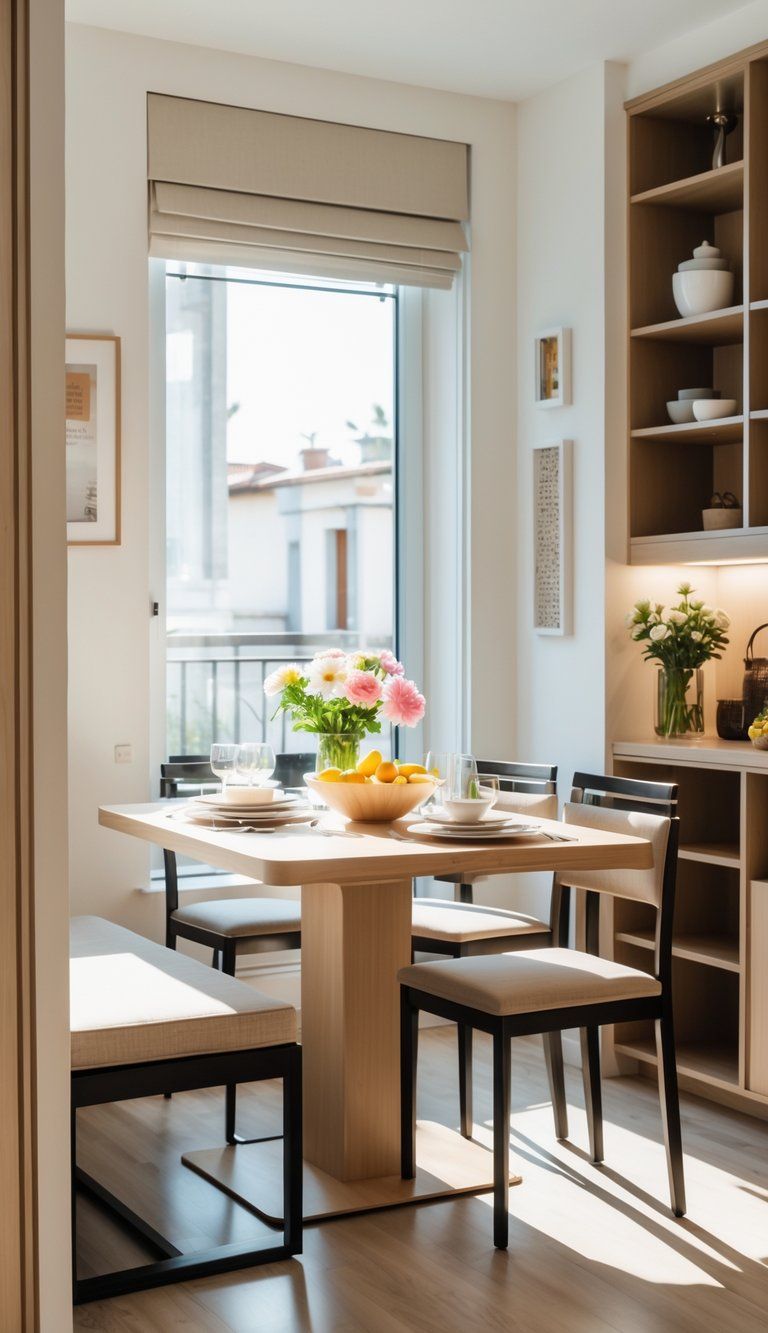
Even a tiny dining area can feel stylish and work well if you make smart choices. The right furniture and a few visual tricks can turn a small spot into a great place for meals and gatherings.
Space-Saving Furniture Ideas
Round or oval tables fit better in tight spaces than rectangles do. They don’t have sharp corners and make it easier to move around.
Look for tables with a pedestal base so you can squeeze in more chairs. Multipurpose furniture makes life easier in small rooms.
Try drop-leaf or extendable tables that shrink down when you don’t need them. Benches that tuck under the table, chairs that double as living room seating, or wall-mounted tables that fold away all help maximize your space.
Built-in banquettes along a wall save space and give you extra storage underneath. This creates a cozy dining nook that makes the most of every inch.
Visual Tricks for a Larger Feel
Light colors make a small dining room feel bigger. White or pale walls reflect light and keep things airy. Glass tables help lighten up the look, too.
Mirrors work wonders—hang a big one on the wall to double the space visually and bounce light around. Pendant lights over the table define the area without taking up floor space.
Keep your decor minimal but let it stand out. Go for a few larger pieces instead of lots of small ones. Wall shelves draw the eye up and make the room feel taller.
Transparent chairs, like acrylic or ghost chairs, barely take up visual space but still give you seating. Using the same flooring in connecting rooms helps the dining area blend in and feel like part of a bigger space.
Personalizing Your Dining Space
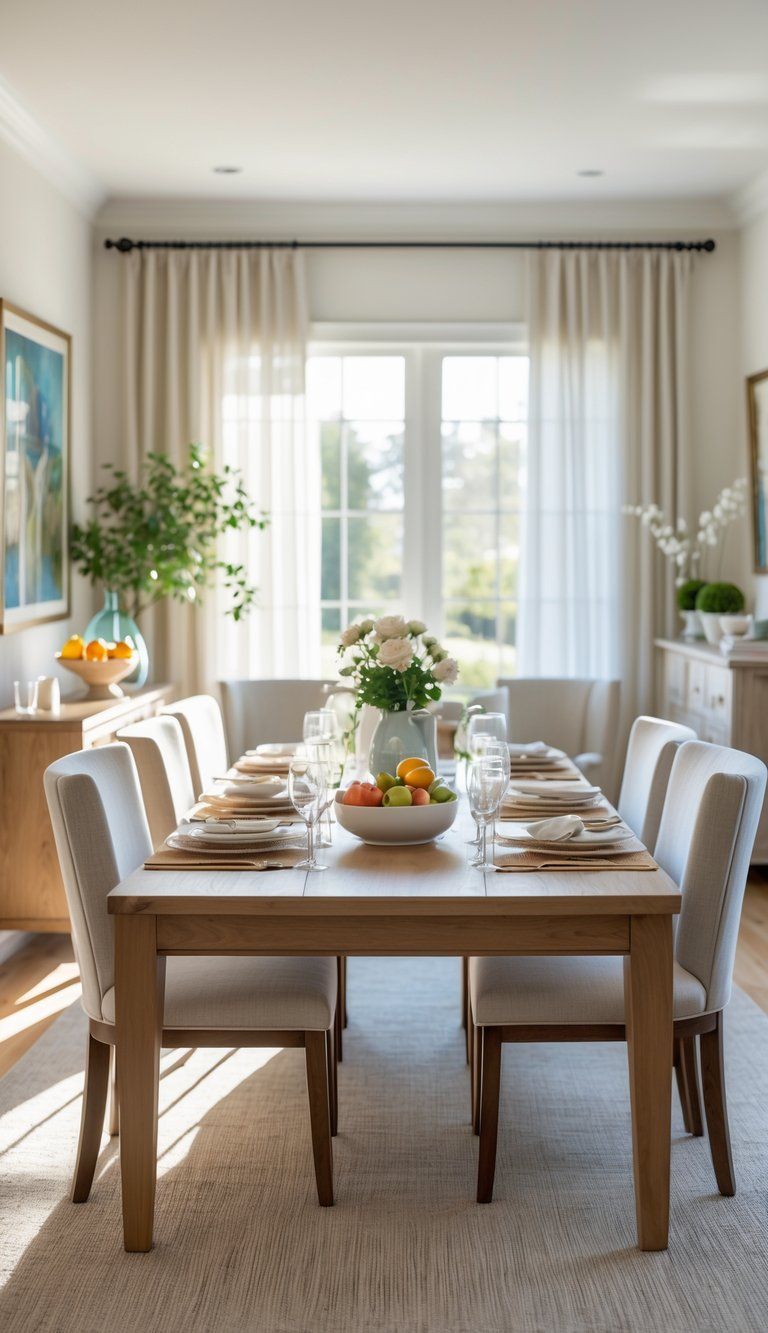
Personal touches turn your dining room from just another eating spot into a space that really feels like yours. The right decor brings in personality and keeps things interesting.
Showcasing Art and Collectibles
Statement art creates a focal point in your dining room. Pick pieces that spark conversation and fit your overall vibe.
A big, bold painting above a sideboard can anchor the whole room. Gallery walls also look great—mix framed photos, prints, and small art pieces for a collected feel.
Keep balance by mixing sizes but sticking to a color theme. Show off collectibles in glass-front cabinets or on open shelves.
Family heirlooms, special dishes, or travel souvenirs all add character and stories. Rotate what you display now and then to keep things feeling fresh.
Mixing Textures and Materials
Mixing different textures brings real depth and a bit of visual spark to your dining room. Try pairing smooth surfaces like glass or polished metal with something rougher, maybe natural wood or a textured fabric.
A wood ceiling? That instantly adds warmth and a lot of character. You could go with reclaimed beams, some kind of coffered design, or just simple wood planks—whatever you pick, it’s going to draw the eye upward and give the room a little architectural punch.
Layer in textiles with your window treatments, chair upholstery, or even table linens. It helps to mix patterns and materials, but stick to a color palette that feels right so things don’t get too chaotic.
Don’t be afraid to try unexpected material combinations for your dining furniture. A stone tabletop with metal legs? Or maybe upholstered chairs with wooden frames? Those kinds of choices add contrast and make your dining space feel intentionally put together—definitely not mass-produced.

